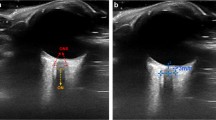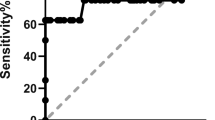Abstract
Purpose
Previous studies correlating ultrasound (US)-based optic nerve sheath diameter (ONSD) and intracranial pressure (ICP) in children were performed under general anesthesia. To apply ONSD in daily clinical routine, it is necessary to investigate patients awake. It is furthermore essential for ICP-assessment with ONSD to know if ONSD-ICP correlation varies within individuals. In this study, we report on the influence of wakefulness, method of ICP measurement, intraindividual correlations, and dynamic changes of ONSD and ICP after ICP decreasing therapy.
Methods
The overall study included 72 children with a median age of 5.2 years. US ONSD determination was performed immediately prior to invasive ICP measurement, and the mean binocular ONSD was compared to ICP. In 10 children, a minimum of 3 ONSD/ICP measurements were performed to investigate a correlation within subjects. In 30 children, measurements were performed before and after therapy.
Results
Twenty-eight children were investigated awake with an excellent correlation of ONSD and ICP (r = 0.802, p < 0.01). In 10 children, at least three simultaneous ONSD and ICP measurements were performed. The intraindividual correlations were excellent (r = 0.795–1.0) however with strongly differing individual regression curves. The overall correlation within subjects was strong (r = 0.78, p < 0.01). After ICP decreasing therapy, all ONSD values decreased significantly (p < 0.01); however, there was no correlation between ∆ICP and ∆ONSD.
Conclusion
Awake investigation does not impair the correlation between ONSD and ICP. Even if there is a good overall ONSD-ICP correlation, every individual has its own distinctive and precise correlation line. The relationship between ONSD and ICP is furthermore not uniform between individuals. Strong ICP decreases can lead to smaller ONSD changes and vice versa. This should be kept in mind when using this technique in the clinical daily routine.





Similar content being viewed by others
References
Raffiz M, Abdullah JM (2017) Optic nerve sheath diameter measurement: a means of detecting raised ICP in adult traumatic and non-traumatic neurosurgical patients. Am J Emerg Med 35:150–153
Robba C, Cardim D, Tajsic T, Pietersen J, Bulman M, Donnelly J, Lavinio A, Gupta A, Menon DK, Hutchinson PJA, Czosnyka M (2017) Ultrasound non-invasive measurement of intracranial pressure in neurointensive care: a prospective observational study. PLoS Med 14:e1002356
Liu D, Li Z, Zhang X, Zhao L, Jia J, Sun F, Wang Y, Ma D, Wei W (2017) Assessment of intracranial pressure with ultrasonographic retrobulbar optic nerve sheath diameter measurement. BMC Neurol 17:188
Padayachy LC, Padayachy V, Galal U, Gray R, Fieggen AG (2016) The relationship between transorbital ultrasound measurement of the optic nerve sheath diameter (ONSD) and invasively measured ICP in children: part I: repeatability, observer variability and general analysis. Child’s nervous system : ChNS : official journal of the International Society for Pediatric Neurosurgery 32:1769–1778
Padayachy LC, Padayachy V, Galal U, Pollock T, Fieggen AG (2016) The relationship between transorbital ultrasound measurement of the optic nerve sheath diameter (ONSD) and invasively measured ICP in children. Part II: age-related ONSD cut-off values and patency of the anterior fontanelle. Child’s nervous system : ChNS : official journal of the International Society for Pediatric Neurosurgery 32:1779–1785
Steinborn M, Friedmann M, Makowski C, Hahn H, Hapfelmeier A, Juenger H (2016) High resolution transbulbar sonography in children with suspicion of increased intracranial pressure. Child’s nervous system : ChNS : official journal of the International Society for Pediatric Neurosurgery 32:655–660
Ozturk Z, Atalay T, Arhan E, Aydin K, Serdaroglu A, Hirfanoglu T, Havali C, Akbas Y, Yalinbas D (2017) The efficacy of orbital ultrasonography and magnetic resonance imaging findings with direct measurement of intracranial pressure in distinguishing papilledema from pseudopapilledema. Child’s nervous system : ChNS : official journal of the International Society for Pediatric Neurosurgery 33:1501–1507
Hansen HC, Lagreze W, Krueger O, Helmke K (2011) Dependence of the optic nerve sheath diameter on acutely applied subarachnoidal pressure - an experimental ultrasound study. Acta Ophthalmol 89:e528–e532
Kerscher SR, Schoni D, Hurth H, Neunhoeffer F, Haas-Lude K, Wolff M, Schuhmann MU (2019) The relation of optic nerve sheath diameter (ONSD) and intracranial pressure (ICP) in pediatric neurosurgery practice - part I: correlations, age-dependency and cut-off values. Child’s nervous system : ChNS : official journal of the International Society for Pediatric Neurosurgery
Heisey SR, Adams T (1993) Role of cranial bone mobility in cranial compliance. Neurosurgery 33:869–876 discussion 876-867
Hassen GW, Al-Juboori M, Koppel B, Akfirat G, Kalantari H (2018) Real time optic nerve sheath diameter measurement during lumbar puncture. Am J Emerg Med 36:736.e731–736.e733
Wang LJ, Chen LM, Chen Y, Bao LY, Zheng NN, Wang YZ, Xing YQ (2018) Ultrasonography assessments of optic nerve sheath diameter as a noninvasive and dynamic method of detecting changes in intracranial pressure. JAMA ophthalmology 136:250–256
Le A, Hoehn ME, Smith ME, Spentzas T, Schlappy D, Pershad J (2009) Bedside sonographic measurement of optic nerve sheath diameter as a predictor of increased intracranial pressure in children. Ann Emerg Med 53:785–791
Fogel MA, Pawlowski TW, Harris MA, Whitehead KK, Keller MS, Wilson J, Tipton D, Harris C (2011) Comparison and usefulness of cardiac magnetic resonance versus computed tomography in infants six months of age or younger with aortic arch anomalies without deep sedation or anesthesia. Am J Cardiol 108:120–125
Neubauer V, Griesmaier E, Baumgartner K, Mallouhi A, Keller M, Kiechl-Kohlendorfer U (2011) Feasibility of cerebral MRI in non-sedated preterm-born infants at term-equivalent age: report of a single centre. Acta paediatrica (Oslo, Norway: 1992) 100:1544–1547
Shariat M, Mertens L, Seed M, Grosse-Wortmann L, Golding F, Mercer-Rosa L, Harris M, Whitehead KK, Li C, Fogel MA, Yoo SJ (2015) Utility of feed-and-sleep cardiovascular magnetic resonance in young infants with complex cardiovascular disease. Pediatr Cardiol 36:809–812
Avery RA, Mistry RD, Shah SS, Boswinkel J, Huh JW, Ruppe MD, Borasino S, Licht DJ, Seiden JA, Liu GT (2010) Patient position during lumbar puncture has no meaningful effect on cerebrospinal fluid opening pressure in children. J Child Neurol 25:616–619
Ganslandt O, Mourtzoukos S, Stadlbauer A, Sommer B, Rammensee R (2018) Evaluation of a novel noninvasive ICP monitoring device in patients undergoing invasive ICP monitoring: preliminary results. J Neurosurg 128:1653–1660
Bhatia A, Gupta AK (2007) Neuromonitoring in the intensive care unit. I. Intracranial pressure and cerebral blood flow monitoring. Intensive Care Med 33:1263–1271
Hockel K, Schuhmann MU (2018) ICP monitoring by open extraventricular drainage: common practice but not suitable for advanced neuromonitoring and prone to false negativity. Acta Neurochir Suppl 126:281–286
Klein SP, Bruyninckx D, Callebaut I, Depreitere B (2018) Comparison of intracranial pressure and pressure reactivity index obtained through pressure measurements in the ventricle and in the parenchyma during and outside cerebrospinal fluid drainage episodes in a manipulation-free patient setting. Acta Neurochir Suppl 126:287–290
Sithinamsuwan P, Sithinamsuwan N, Tejavanija S, Udommongkol C, Nidhinandana S (2008) The effect of whole body position on lumbar cerebrospinal fluid opening pressure. Cerebrospinal Fluid Res 5:11
Laurie SS, Vizzeri G, Taibbi G, Ferguson CR, Hu X, Lee SMC, Ploutz-Snyder R, Smith SM, Zwart SR, Stenger MB (2017) Effects of short-term mild hypercapnia during head-down tilt on intracranial pressure and ocular structures in healthy human subjects. Physiological reports 5
Killer HE, Jaggi GP, Flammer J, Miller NR, Huber AR, Mironov A (2007) Cerebrospinal fluid dynamics between the intracranial and the subarachnoid space of the optic nerve. Is it always bidirectional? Brain 130:514–520
Lawlor M, Zhang MG, Virgo J, Plant GT (2016) Asymmetrical intraocular pressures and asymmetrical papilloedema in pseudotumor cerebri syndrome. Neuro-ophthalmology (Aeolus Press) 40:292–296
Pircher A, Montali M, Berberat J, Remonda L, Killer HE (2017) Relationship between the optic nerve sheath diameter and lumbar cerebrospinal fluid pressure in patients with normal tension glaucoma. Eye (London, England) 31:1365–1372
Killer HE, Miller NR, Flammer J, Meyer P, Weinreb RN, Remonda L, Jaggi GP (2012) Cerebrospinal fluid exchange in the optic nerve in normal-tension glaucoma. Br J Ophthalmol 96:544–548
Hou R, Zhang Z, Yang D, Wang H, Chen W, Li Z, Sang J, Liu S, Cao Y, Xie X, Ren R, Zhang Y, Sabel BA, Wang N (2016) Intracranial pressure (ICP) and optic nerve subarachnoid space pressure (ONSP) correlation in the optic nerve chamber: the Beijing Intracranial and Intraocular Pressure (iCOP) study. Brain Res 1635:201–208
Bakbak B, Donmez H, Kansu T, Kiratli H (2009) Dural ectasia of the optic nerve sheath: is it always benign? Eye and brain 1:5–7
Kacem HH, Hammani L, Ajana A, Nassar I (2014) Dural ectasia of the optic nerve sheath. Pan Afr med j 17:140
Mesa-Gutierrez JC, Quinones SM, Ginebreda JA (2008) Optic nerve sheath meningocele. Clin ophthalmol (Auckland, NZ) 2:661–668
Halimi E, Wavreille O, Rosenberg R, Bouacha I, Lejeune JP, Defoort-Dhellemmes S (2013) Optic nerve sheath meningocele: a case report. Neuro-ophthalmology (Aeolus Press) 37:78–81
Acknowledgments
We are deeply indebted to Juergen Beck, MD PhD, University of Bern and Freiburg, who inspired our interest in ultrasound determination of ONSD and to Llewellyn Padayachy, MD PhD, University of CapeTown and Pretoria, for many fruitful discussions over the years.
Author information
Authors and Affiliations
Corresponding author
Ethics declarations
The study was approved by the institutional ethics committee (project number: 180/2018B02).
Conflict of interest
The authors have no potential conflict of interests to declare.
Additional information
Publisher’s note
Springer Nature remains neutral with regard to jurisdictional claims in published maps and institutional affiliations.
Rights and permissions
About this article
Cite this article
Kerscher, S.R., Schöni, D., Neunhoeffer, F. et al. The relation of optic nerve sheath diameter (ONSD) and intracranial pressure (ICP) in pediatric neurosurgery practice - Part II: Influence of wakefulness, method of ICP measurement, intra-individual ONSD-ICP correlation and changes after therapy. Childs Nerv Syst 36, 107–115 (2020). https://doi.org/10.1007/s00381-019-04336-4
Received:
Accepted:
Published:
Issue Date:
DOI: https://doi.org/10.1007/s00381-019-04336-4




